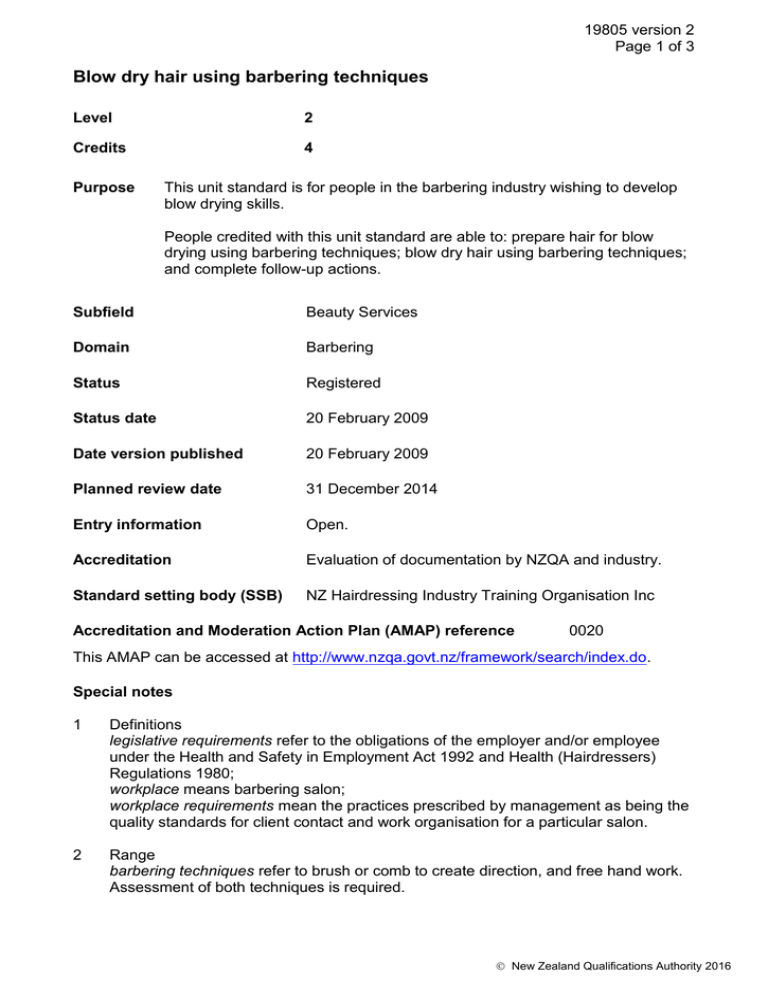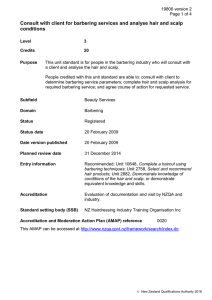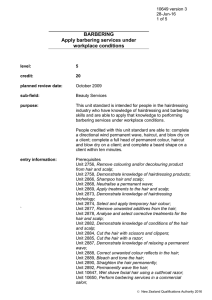Blow dry hair using barbering techniques
advertisement

19805 version 2 Page 1 of 3 Blow dry hair using barbering techniques Level 2 Credits 4 Purpose This unit standard is for people in the barbering industry wishing to develop blow drying skills. People credited with this unit standard are able to: prepare hair for blow drying using barbering techniques; blow dry hair using barbering techniques; and complete follow-up actions. Subfield Beauty Services Domain Barbering Status Registered Status date 20 February 2009 Date version published 20 February 2009 Planned review date 31 December 2014 Entry information Open. Accreditation Evaluation of documentation by NZQA and industry. Standard setting body (SSB) NZ Hairdressing Industry Training Organisation Inc Accreditation and Moderation Action Plan (AMAP) reference 0020 This AMAP can be accessed at http://www.nzqa.govt.nz/framework/search/index.do. Special notes 1 Definitions legislative requirements refer to the obligations of the employer and/or employee under the Health and Safety in Employment Act 1992 and Health (Hairdressers) Regulations 1980; workplace means barbering salon; workplace requirements mean the practices prescribed by management as being the quality standards for client contact and work organisation for a particular salon. 2 Range barbering techniques refer to brush or comb to create direction, and free hand work. Assessment of both techniques is required. New Zealand Qualifications Authority 2016 19805 version 2 Page 2 of 3 3 In this unit standard all work must comply with legislative requirements and must ensure optimum hair condition and maximum client comfort at all times. 4 For assessment against this unit standard, hair to be blow dried should previously have been cut using barbering techniques. Elements and performance criteria Element 1 Prepare hair for blow drying using barbering techniques. Performance criteria 1.1 The work needed is identified and confirmed with client. 1.2 The hair and scalp are analysed in accordance with workplace requirements. Range porosity, elasticity, texture, density, length, scalp conditions, growth patterns, previous product build-up. 1.3 The style to be blow dried is selected in accordance with confirmed outcome and compatibility with hair and scalp analysis. 1.4 Client is protected against water and/or product spillage. 1.5 Tools are selected to meet the requirements of selected style. 1.6 Hair is prepared for blow drying in accordance with hair and scalp analysis, product instructions, and confirmed outcome. Range hydrogen bonds broken. Element 2 Blow dry hair using barbering techniques. Performance criteria 2.1 Styling products are selected and applied to hair in accordance with the manufacturer’s instructions, hair analysis, and following service requirements. 2.2 Hair is blow dried to meet confirmed outcome and leave hair in optimum condition. 2.3 Dried hair is placed and finished to meet the confirmed outcome and to ensure maximum hair protection. 2.4 Blow dry is completed within ten minutes. New Zealand Qualifications Authority 2016 19805 version 2 Page 3 of 3 Element 3 Complete follow-up actions. Performance criteria 3.1 Home haircare advice is provided that is consistent with client’s hair type and completed service. Range product type, hair maintenance. 3.2 Tools and equipment are sanitised in accordance with workplace requirements. 3.3 Work area is cleaned and tidied in accordance with workplace requirements. Please note Providers must be accredited by NZQA, or an inter-institutional body with delegated authority for quality assurance, before they can report credits from assessment against unit standards or deliver courses of study leading to that assessment. Industry Training Organisations must be accredited by NZQA before they can register credits from assessment against unit standards. Accredited providers and Industry Training Organisations assessing against unit standards must engage with the moderation system that applies to those standards. Accreditation requirements and an outline of the moderation system that applies to this standard are outlined in the Accreditation and Moderation Action Plan (AMAP). The AMAP also includes useful information about special requirements for organisations wishing to develop education and training programmes, such as minimum qualifications for tutors and assessors, and special resource requirements. Comments on this unit standard Please contact the NZ Hairdressing Industry Training Organisation Inc enquiries@hito.org.nz if you wish to suggest changes to the content of this unit standard. New Zealand Qualifications Authority 2016





